The concept of a set is something we encounter frequently in our daily language, from phrases like “tea set” or “sofa set.” It is indeed intriguing how mathematicians have transformed this everyday word into a fundamental mathematical concept that serves as a language used across various branches of modern mathematics. In mathematical terms, a set is defined as a well-defined collection of distinct objects.
A well-defined collection implies that for any given object, we can determine whether it belongs to the set or not. The elements within a set are referred to as its members or elements. Sets are often denoted with capital letters like A, B, C, X, Y, Z, while the elements within them are represented by small letters like a, b, c, x, y, z. There are three main methods of describing a set: the Descriptive Method, where a set is described in words (e.g., the set of all English alphabet vowels); the Tabular Method, where elements are listed within braces (e.g., A = {a, e, i, o, u}); and the Set-builder Method, which uses a common property to specify the set (e.g., A = {x | x is a vowel of the English alphabet}).
Sets can contain various types of elements, including numbers, and there are several well-known sets like the natural numbers (N), whole numbers (W), integers (Z), negative integers (Z’), odd integers (O), even integers (E), rational numbers (Q), and irrational numbers (Q’). These sets play essential roles in mathematical exploration and analysis. Sets can also be classified as finite or infinite, depending on whether they can be paired with a finite set of natural numbers. A subset is a set in which every element is also found in another set, denoted as A ⊆ B. If B contains at least one element that is not in A, then A is considered a proper subset of B, written as A ⊂ B.
The empty set, which contains no elements, is a subset of every set. The power set of a set S (denoted as P(S)) consists of all possible subsets of S. The universal set, or universe of discourse, is a larger set that contains all the subsets we are studying in a particular context. It serves as a reference point for our mathematical discussions, and the choice of the universal set may vary depending on the specific mathematical domain we are exploring.

